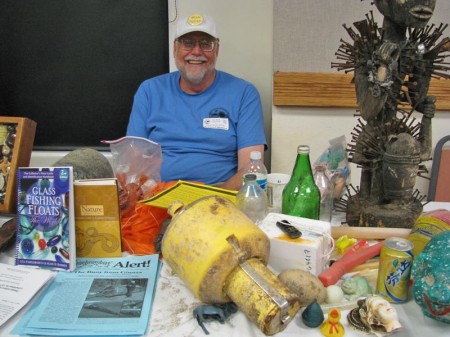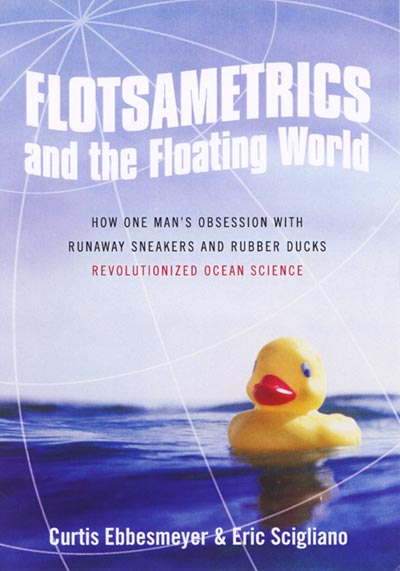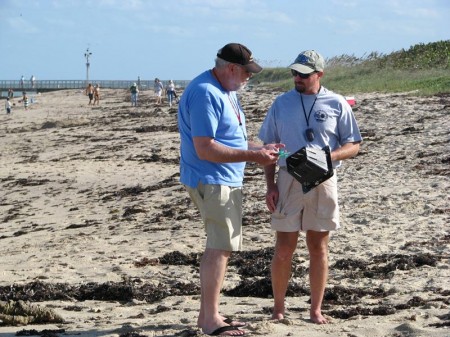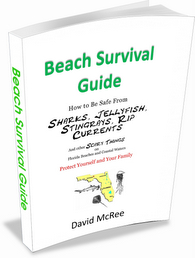
Dr. Curtis Ebbesmeyer with some flotsam from the beach.
What do rubber ducks have to do with ocean science? The same thing flotsam in general has to do with it. Flotsam is that stuff, natural or manmade, that’s floating around in the ocean. Nowadays, there’s an unbelievable amount of manmade stuff, especially plastic, that is floating in the oceans, caught up in the currents, and circling the oceans, sometimes for decades, before washing up on a beach somewhere.
I had the pleasure of meeting Dr. Ebbesmeyer at the 13th Annual International Seabean Symposium in Cocoa Beach in October 2008. He presented a very interesting slide show. Here are a few bits and pieces from Dr. Ebbesmeyer’s slide show:
- Plastic from as far back as 1944 was found in an albatross in 2005. The stuff hangs around for a long time.
- Florida’s Atlantic coast is one of the best places for beachcombing because of the North Atlantic Gyre, a huge circular current that passes the US east coast, Western Europe, and Africa.
- It takes about 3 years for a piece of flotsam to go around the gyre, but the longest documented ride taken by a piece of flotsam was a bottle that spent 35 years drifting in the gyre.
I thought it was all just a lot of fun–collecting flotsam, beachcombing, studying ocean currents–but there is a darker implication to all the junk floating in the oceans. This was brought home by “shed bird.”
This poor bird (I forget the species–some seabird) had made a nest in a shed in someone’s yard and was raising a chick. The baby bird did not survive. Upon autopsy, 512 pieces of plastic were found in the birds stomach. Enough to kill anything. Some fish attach their eggs to floating objects. Birds that eat the eggs ingest the object (in this case, plastic) then regurgitate the deadly meal to their chicks before the chicks’ stomachs have developed enough to expel indigestible matter.
Here’s a short, but informative video clip on what Dr. Ebbesmeyer does:
Dr. Ebbesmeyer is also a forensic oceanographer. This means that when a human body, or body parts wash up on the beach, he is often called in to help with the identification process. I won’t go into the details here, but remember the stories about the shoes (with human feet still inside them) washing up on Canadian beaches? Dr. Ebbesmeyer was quoted in the UK Guardian:
“The big picture is that there are body parts washing up all over the place all the time,” said Curtis Ebbesmeyer… But this, he admits, is different. “I’ve never come across a time when we’ve had five of one kind [all feet]at one time. It’s highly unusual.”… “The shoe is going to protect the foot pretty well,” Ebbesmeyer said. “Most shoes float, and sneakers tend to float sole up, so that would protect them from birds.”
After the Sea-Bean Symposium was over, some of us drove down to Sebastian Inlet to hunt for sea-beans. While we were goofing off, Dr. Ebbesmeyer and Dr. Blair Witherington ( a research scientist and author of Florida’s Living Beaches) were filmed discussing various items found on the beach. These educational video clips, which promise to be very interesting, will appear on the Space Coast Beach Blog.
You won’t want to miss the new book by Dr. Ebbesmeyer, co authored with Eric Scigliano. It’s called Flotsametrics and the Floating World: How One Man’s Obsession with Runaway Sneakers and Rubber Ducks Revolutionized Ocean Science. It’s coming out in March 2009.
From the promotional material:
Curtis Ebbesmeyer is no ordinary scientist, and for the first time, he tells the story of his life–long struggle to solve the sea’s mysteries–uncovering the astonishing story of flotsam, unraveling the mystery of marine currents, and changing the world’s view of trash, the ocean, and our global environment.

You’ll also want to visit Dr. Ebbesmeyer’s website www.beachcombersalert.org, and subscribe to his newsletter Beachcombers’ Alert to stay informed on what kind of crazy and interesting things people are finding on beaches these days…like a 1 million pint beer fermentation tank, for instance.



